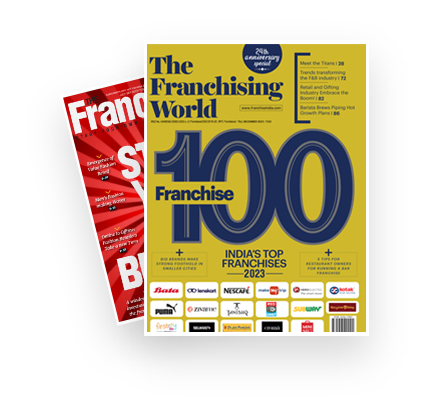
Sikkim, the Himalayan paradise nestled in India’s northeast, is a land of breathtaking natural beauty, rich cultural heritage, and, most importantly, distinct, tantalising cuisine. Its emphasis on organic farming, thriving tourist industry, and locals' love of traditional flavours make it an ideal place for aspiring business owners. Starting a food business doesn't always require massive capital. For those dreaming of culinary ventures in this serene state, a host of low-investment food business ideas in Sikkim are waiting to be explored. This post explores seven of these options in detail, providing practical advice and emphasising why Sikkim is the ideal location for your culinary adventure. Read this till the end before opening a business in Sikkim to know if it's a great fit for you.
Also read: 5 Biggest Mistakes First-Time Franchise Investors Make
1. The Hidden Gem: Your Own Delivery-Only Kitchen
This is a kitchen that only cooks for delivery, partnering with apps like Swiggy or doing its own deliveries. Your focus is entirely on the food.
Why it Works Here: Tourists are exhausted after a day of sightseeing, and locals are just as busy. The demand for good food delivered to the doorstep is only growing.
Don't just make generic Chinese food. Be the one who delivers a perfect "Sikkimese Soul Food Thali" – a proper plate of dal, gundruk ko jhol, rice, and a potato fry. That’s a meal that tells a story.
Estimated Investment:
The estimated investment is medium-high and is typically around ₹50,000 - ₹2,00,000, which includes:
FSSAI License & Local Trade License: Absolutely non-negotiable. This is your foundation.
Kitchen Gear: A good commercial gas stove, a large refrigerator, pots, pans, and storage containers.
Packaging: You'll need good-quality, leak-proof containers and bags. Brand them with a simple logo.
Marketing: A little budget for social media ads or promotions on the food delivery apps.
How to Start:
Lock in Your Menu: Don't try to do 50 things. Start with 5-7 knockout dishes you can make perfectly every time.
Get Legal: Visit the municipal office for a trade licence and apply online for your FSSAI licence. It’s a bit of paperwork, but it’s your ticket to legitimacy.
Set Up Shop: Equip your kitchen. It doesn't need to be big, just efficient and spotlessly clean.
Go Live Online: Reach out to Swiggy and Zomato to get on their platform. Simultaneously, create a simple Instagram page and start posting drool-worthy photos of your food.
2. The Momo Maverick: Reinventing a Classic
Momos are our heartbeat. But instead of being the 20th momo stall selling the same thing, get creative with fillings and sauces. Think chhurpi (local cheese) and spinach momos, or a minced pork momo with a unique smoky sauce. The dipping chutneys are your secret weapon – a creamy sesame one, a zesty yoghurt-mint, or a next-level tomato achar.
Estimated Investment:
The estimated investment is low and is typically around ₹20,000 - ₹80,000, which includes:
This is one of the most accessible starts.
The Big Costs:
Stall/Kiosk: You can rent a small stall in a busy area or even get a portable cart made.
Equipment: Large steamers (momo cookers), a preparation table, and basic utensils.
Initial Supplies: Funds for your first bulk buy of flour, meat/veggies, and spices.
Hawker License: A must-have from your local municipality.
How to Start:
Perfect Your Recipe: Test your unique momos and chutneys on friends and family until they can't get enough.
Scout a Location: Find a spot with good foot traffic – near colleges, office areas, or popular tourist lanes.
Get Your Licenses: Walk into the municipal corporation and get your hawker license. It keeps you safe from fines.
Soft Launch: Start small. Don't announce it to the world on day one. Get your operations smooth, then start putting up a colourful sign and telling everyone about your "special momos".
Also read: Top 10 Cafe Franchise To Consider in India
3. The Pantry Preserver: Jars of Sikkimese Sunshine
This business is about bottling that tradition – selling homemade pickles, chutneys, and packaged gundruk.
The Appeal: For tourists, it’s the perfect edible souvenir. For locals living outside Sikkim, it’s a taste of home.
Estimated Investment:
The estimated investment is low to medium and is typically around ₹15,000 - ₹1,00,000, which includes:
You can literally start from your kitchen counter.
The Big Costs:
Raw Materials: Buy seasonal veggies like tomatoes and dalle khursani in bulk when they're cheapest.
Packaging: Glass jars, lids, and labels. Design a simple, pretty label on a free tool like Canva.
FSSAI Basic Registration: Essential for selling packaged food.
Market Stall Fee: A small cost to sell at a local weekend market.
How to Start:
Standardise Your Recipe: Make sure your achar tastes amazing and consistent every single time.
Get Your License: The FSSAI Basic Registration is for small businesses and is quite straightforward to get online.
Create Your Brand: Think of a warm, personal name (e.g., "Ama's Kitchen"). Buy your jars and get your labels printed.
Find Your First Customers: Book a stall at a local haat or Sunday market. This is your testing ground. The direct feedback is priceless.
4. The Snack Box Curator: A Taste of Home, Delivered
.png)
A weekly subscription or on-demand service that delivers boxes of traditional Sikkimese snacks to offices and homes.
Solves a Problem: Who has time to make shakam paa, sel roti, and khabzey on a weekdays? You do it for them.
Estimated Investment:
The estimated investment is medium to high and is typically around ₹30,000 - ₹1,20,000, which includes:
The Big Costs:
Kitchen Equipment: Standard home kitchen gear, but you might need an extra burner or a large kadai.
Delivery Bike: A second-hand scooter or bike for deliveries is a huge plus. Initially, you can deliver locally yourself.
Eco-friendly Packaging: Compartmentalised boxes that look good.
Marketing: Creating a simple WhatsApp catalogue or a Facebook/Instagram page.
How to Start:
Design Your Boxes: Create a weekly menu. Maybe Week 1 is Shakam Paa and Sel Roti. Week 2 is Gundruk Ko Jhol and Khabzey.
Set Up Your "Shop": Create a dedicated WhatsApp number for orders and a simple Instagram page filled with photos of your snack boxes.
Start with a Pilot: Offer your first week to friends and family at a discount in exchange for honest reviews and photos.
Deliver & Delight: Focus on punctuality and presentation. A happy customer will share your WhatsApp number with their entire office.
5. The Tea & Tipple Taster: A Sip of the Mountains
A small, elegant kiosk that offers a tasting experience of Sikkim’s two iconic drinks: Temi Tea and local brews like Chang and Raksi.
The Experience: It’s not a bar; it’s a cultural stop. Educate people on the different flushes of Temi Tea and serve Chang in the traditional Tongba.
Estimated Investment:
The estimated investment is medium to very high and is typically around ₹80,000 - ₹2,00,000, which includes:
This one is a bit higher due to the liquor license.
The Big Costs:
Liquor License: This can be a process and a significant cost, but it's mandatory. Start inquiries early.
Kiosk Rental: In a high-footfall tourist area like MG Marg or near a popular viewpoint.
Inventory: Buying stocks of Temi Tea (direct from the garden if possible), Chang, and Raksi.
Unique Serving Ware: Traditional Tongbas, nice teacups, and tasting glasses.
How to Start:
Navigate the License: This is your first and biggest hurdle. Talk to the Excise Department to understand the process and cost for a retail license.
Source Your Products: Build relationships with local brewers and tea distributors. Your story is stronger if you know the source.
Design the Experience: Create a simple "Tasting Platter"—a small pot of first-flush tea, a Tongba, and a tiny sample of Raksi.
Open Your Doors: Train yourself to tell the story behind each drink. Your knowledge is what will make the experience memorable.
Also read: Brewberry franchise: Cost, Requirements & How to apply
6. The Morning Boost: A Healthy Breakfast Nook
A small, bright spot dedicated entirely to healthy, organic, and quick breakfasts.
Fills a Gap: For all the office-goers, students, and health-conscious tourists looking for more than just fried snacks in the morning.
Estimated Investment:
The estimated investment is medium to very high and is typically around ₹80,000 - ₹2,50,000, which includes:
The Big Costs:
Small Shop Rental: Location is key—near a bus stop, college, or office complex.
Equipment: A blender for smoothies, a sandwich press, a griddle, and a fridge.
Initial Organic Stock: Sourcing local millets (kodo, fapar), honey, and fresh produce.
Takeaway Packaging: Cups, bowls, and wrappers.
How to Start:
Craft Your Menu: Feature things like Kodo millet porridge, organic egg wraps, and fresh fruit smoothie bowls. Use "100% Organic" as your main selling point.
Find Your Spot: A small, affordable space in a high-footfall area is worth its weight in gold.
Stock Up: Connect with local farmers or co-ops to get your organic supplies.
The Early Bird Launch: Open your doors at 7 AM. Offer a "First Week Discount" to build a habit among your first customers.
Also read: WOW! Momo Franchise: Investment, Profit and Process
7. The Trekker's Fuel: Food for the Journey
Create lightweight, non-perishable, and energising food packs specifically for trekkers and backpackers.
Solves a Real Problem: Trekking food is often boring and heavy. Your products are the solution.
Estimated Investment:
The estimated investment is low to medium and is typically around ₹40,000 - ₹1,50,000, which includes:
The Big Costs:
Specialised Equipment: A dehydrator (for making dried soups) and a vacuum sealer are big investments but crucial for shelf life.
Packaging: Mylar pouches that are lightweight and airtight.
Raw Materials: Ingredients for energy bars (oats, nuts, chhurpi), tea, and soup mixes.
FSSAI License: Mandatory for any packaged food.
How to Start:
Product Development: Make sure your instant gur-gur cha just needs hot water and tastes great.
Get the Gear: Invest in the dehydrator and sealer to ensure your products are safe and long-lasting.
Partner Up: This is your sales channel. Go to trekking agencies and gear rental shops in Gangtok and offer them a wholesale price to stock your products.
Sell the Story: Market your products as "Authentic Sikkimese Trekking Fuel". The story is as important as the product itself.
A Final, Heart-to-Heart Word
Sikkim is a country of potential for culinary businesses in addition to being a stunning destination. The hunger for real, heartfelt Sikkimese food is only getting bigger. So, take that dream, spice it up with some hard work, and get cooking. By focusing on local, organic ingredients, celebrating the unique Sikkimese culinary culture, and adopting a low-overhead, high-quality model, aspiring business owners can carve out a profitable niche.
These seven low-investment food business ideas in Sikkim, which range from the handcrafted Dalle Khursani pickle jar to the scalding hot Momo booth, provide a clear way to combine passion and profit. Embrace the organic advantage, charm your customers with authenticity, and you’ll find that your Himalayan food business is not just a venture but a meaningful contribution to the vibrant, green economy of Sikkim.
You might also like: Top 10 Business Ideas You Can Start This Diwali

